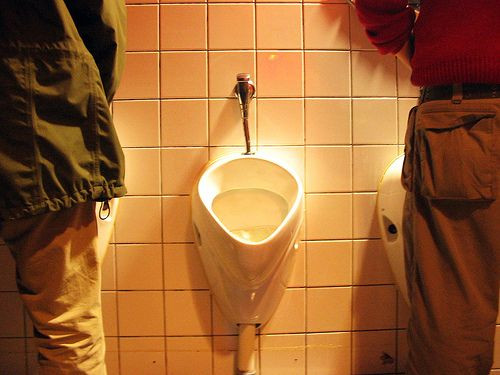Afraid To Pee In Public? Paruresis, ‘Shy Bladder Syndrome,’ Paralyzes 21 Million Americans

For some people, the public restroom experience is a dreadful one. It’s plagued with paralyzing anxiety and unshakeable pangs of stage fright that will only subside with total privacy — a luxury that, on a busy enough day, may never come. Fortunately, sufferers of the condition have science behind their phobia, called paruresis, and solidarity as well, as more than 20 million Americans suffer from the condition.
A Paralyzing Condition
Otherwise known as shy bladder syndrome or pee-shyness, the condition is characterized by a person “locking up” while attempting to urinate in a public setting, resulting in accumulating urine in the bladder. For some, the case of paruresis is so severe that the only solution is home urination or catheterization. While largely derided as a social deficiency, the condition is gaining salience in medical circles as more evidence suggests paruresis is a psychological disorder, not merely a social one.
Roughly seven percent of the American population, or 21 million people, suffers from paruresis, according to the International Paruresis Association.
"What people worry about is being in a bathroom near other people and not being able to urinate, and that others will notice and form judgments about them,” Carl Robbins, director of training for the Anxiety and Stress Disorders Institute of Maryland in Baltimore, told NBC News.
Robbins has worked with paruresis patients for more than 20 years, and has noted that paruresis sufferers are often looked at as if “they're weird, defective, inferior, or for men, not masculine.”
The condition, like many, ranges in severity and is often dependent on the context. In men, the problem may arise depending on how close the nearest person is at a bank of urinals; in women, it may arise when the bathroom is particularly quiet — a tricky situation as women have no choice between urinals or stalls. In both cases, the fundamental difficulty arises from a heightened awareness of the problem. Like many automatic bodily functions, urination — while requiring voluntary action during what’s called the “voiding phase” — depends on unconscious physiological cues to begin.
Paruresis sufferers have reportedly gone hours without being able to urinate, despite feeling the sensation the entire time. Brian Beatty, 51, an Indiana-based machine shop manager, recalled to NBC a recent experience at a NASCAR event.
"Probably my worst experience was going to the Brickyard 400 with coworkers and customers – and holding it in for 14 hours," he said. "While this sounds incredible, this is an everyday reality for individuals with a shy bladder."
Beatty added that he could only urinate in public restrooms if it was empty or he had access to a closed stall. He frequently avoided the issue altogether by limiting his fluid intake and holding it in until he could reach a “safe” bathroom.
"My major issue is privacy, so standing next to someone at a urinal is difficult," he told NBC. "I'm not totally sure what brought this on but there are a couple of childhood incidents of embarrassment by friends and bullying in the school restroom that come to mind."
Beating The Bashful Bladder
The important thing to keep in mind, Robbins adds, is that paruresis is a psychological condition, which means it can be overcome as long as the cycle of fear is broken. "It's clearly a mind-body problem," he says.
Overcoming paruresis, barring any extraneous medical issues, can be accomplished through graduated exposure therapy. The International Paruresis Association (IPA) encourages paruretics to introduce themselves to increasingly more public environments, depending on the specific contexts where the condition most often arises. If a person has trouble with quiet, he or she should begin with large, crowded restrooms — using the noise as a distraction — making sure to drink “one quart of water one hour prior to the practice session.”
Over time, the person should reduce the size of the space and, if possible, the number of people around. The process, known as systematic desensitization, will eventually acclimate the body into feeling comfortable, rather than shock and paralyze it.
“Our data indicate that about 80 percent of paruretics using these techniques are helped to a significant degree,” the IPA states.
Steven Soifer, author of The Shy Bladder Syndrome, corroborates the IPA’s recommendation, noting that, given the attention paid to gradual exposure therapy, the condition merits serious attention and understanding.
"Shy bladder is a real disorder," Soifer said, "not something to be snickered about or laughed at."



























